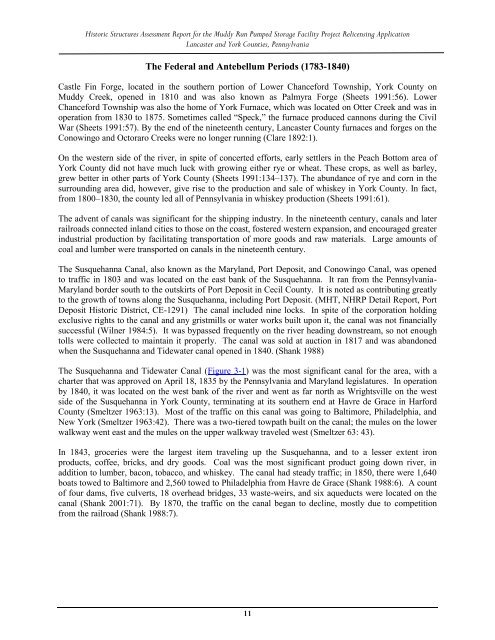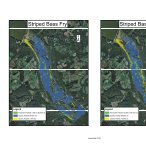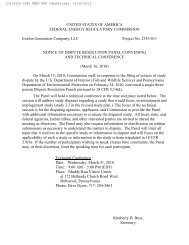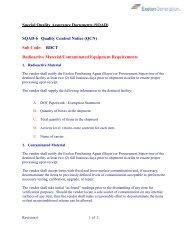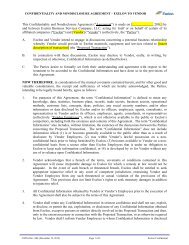Final Report Historical Structures Assessment Report for the Muddy ...
Final Report Historical Structures Assessment Report for the Muddy ...
Final Report Historical Structures Assessment Report for the Muddy ...
You also want an ePaper? Increase the reach of your titles
YUMPU automatically turns print PDFs into web optimized ePapers that Google loves.
Historic <strong>Structures</strong> <strong>Assessment</strong> <strong>Report</strong> <strong>for</strong> <strong>the</strong> <strong>Muddy</strong> Run Pumped Storage Facility Project Relicensing Application<br />
Lancaster and York Counties, Pennsylvania<br />
The Federal and Antebellum Periods (1783-1840)<br />
Castle Fin Forge, located in <strong>the</strong> sou<strong>the</strong>rn portion of Lower Chance<strong>for</strong>d Township, York County on<br />
<strong>Muddy</strong> Creek, opened in 1810 and was also known as Palmyra Forge (Sheets 1991:56). Lower<br />
Chance<strong>for</strong>d Township was also <strong>the</strong> home of York Furnace, which was located on Otter Creek and was in<br />
operation from 1830 to 1875. Sometimes called “Speck,” <strong>the</strong> furnace produced cannons during <strong>the</strong> Civil<br />
War (Sheets 1991:57). By <strong>the</strong> end of <strong>the</strong> nineteenth century, Lancaster County furnaces and <strong>for</strong>ges on <strong>the</strong><br />
Conowingo and Octoraro Creeks were no longer running (Clare 1892:1).<br />
On <strong>the</strong> western side of <strong>the</strong> river, in spite of concerted ef<strong>for</strong>ts, early settlers in <strong>the</strong> Peach Bottom area of<br />
York County did not have much luck with growing ei<strong>the</strong>r rye or wheat. These crops, as well as barley,<br />
grew better in o<strong>the</strong>r parts of York County (Sheets 1991:134–137). The abundance of rye and corn in <strong>the</strong><br />
surrounding area did, however, give rise to <strong>the</strong> production and sale of whiskey in York County. In fact,<br />
from 1800–1830, <strong>the</strong> county led all of Pennsylvania in whiskey production (Sheets 1991:61).<br />
The advent of canals was significant <strong>for</strong> <strong>the</strong> shipping industry. In <strong>the</strong> nineteenth century, canals and later<br />
railroads connected inland cities to those on <strong>the</strong> coast, fostered western expansion, and encouraged greater<br />
industrial production by facilitating transportation of more goods and raw materials. Large amounts of<br />
coal and lumber were transported on canals in <strong>the</strong> nineteenth century.<br />
The Susquehanna Canal, also known as <strong>the</strong> Maryland, Port Deposit, and Conowingo Canal, was opened<br />
to traffic in 1803 and was located on <strong>the</strong> east bank of <strong>the</strong> Susquehanna. It ran from <strong>the</strong> Pennsylvania-<br />
Maryland border south to <strong>the</strong> outskirts of Port Deposit in Cecil County. It is noted as contributing greatly<br />
to <strong>the</strong> growth of towns along <strong>the</strong> Susquehanna, including Port Deposit. (MHT, NHRP Detail <strong>Report</strong>, Port<br />
Deposit Historic District, CE-1291) The canal included nine locks. In spite of <strong>the</strong> corporation holding<br />
exclusive rights to <strong>the</strong> canal and any gristmills or water works built upon it, <strong>the</strong> canal was not financially<br />
successful (Wilner 1984:5). It was bypassed frequently on <strong>the</strong> river heading downstream, so not enough<br />
tolls were collected to maintain it properly. The canal was sold at auction in 1817 and was abandoned<br />
when <strong>the</strong> Susquehanna and Tidewater canal opened in 1840. (Shank 1988)<br />
The Susquehanna and Tidewater Canal (Figure 3-1) was <strong>the</strong> most significant canal <strong>for</strong> <strong>the</strong> area, with a<br />
charter that was approved on April 18, 1835 by <strong>the</strong> Pennsylvania and Maryland legislatures. In operation<br />
by 1840, it was located on <strong>the</strong> west bank of <strong>the</strong> river and went as far north as Wrightsville on <strong>the</strong> west<br />
side of <strong>the</strong> Susquehanna in York County, terminating at its sou<strong>the</strong>rn end at Havre de Grace in Har<strong>for</strong>d<br />
County (Smeltzer 1963:13). Most of <strong>the</strong> traffic on this canal was going to Baltimore, Philadelphia, and<br />
New York (Smeltzer 1963:42). There was a two-tiered towpath built on <strong>the</strong> canal; <strong>the</strong> mules on <strong>the</strong> lower<br />
walkway went east and <strong>the</strong> mules on <strong>the</strong> upper walkway traveled west (Smeltzer 63: 43).<br />
In 1843, groceries were <strong>the</strong> largest item traveling up <strong>the</strong> Susquehanna, and to a lesser extent iron<br />
products, coffee, bricks, and dry goods. Coal was <strong>the</strong> most significant product going down river, in<br />
addition to lumber, bacon, tobacco, and whiskey. The canal had steady traffic; in 1850, <strong>the</strong>re were 1,640<br />
boats towed to Baltimore and 2,560 towed to Philadelphia from Havre de Grace (Shank 1988:6). A count<br />
of four dams, five culverts, 18 overhead bridges, 33 waste-weirs, and six aqueducts were located on <strong>the</strong><br />
canal (Shank 2001:71). By 1870, <strong>the</strong> traffic on <strong>the</strong> canal began to decline, mostly due to competition<br />
from <strong>the</strong> railroad (Shank 1988:7).<br />
11


